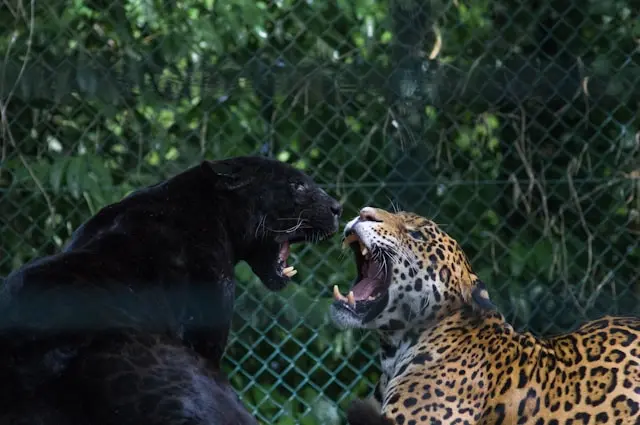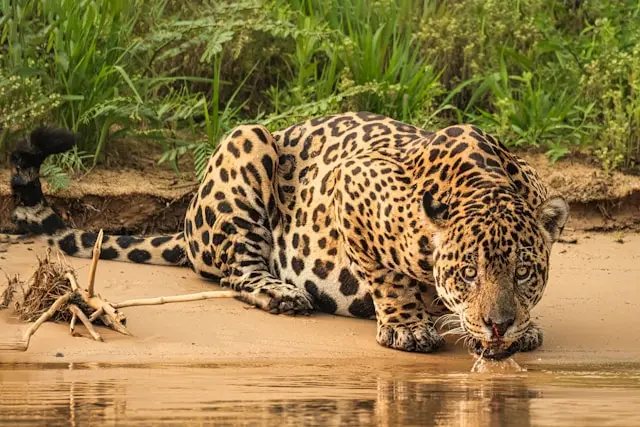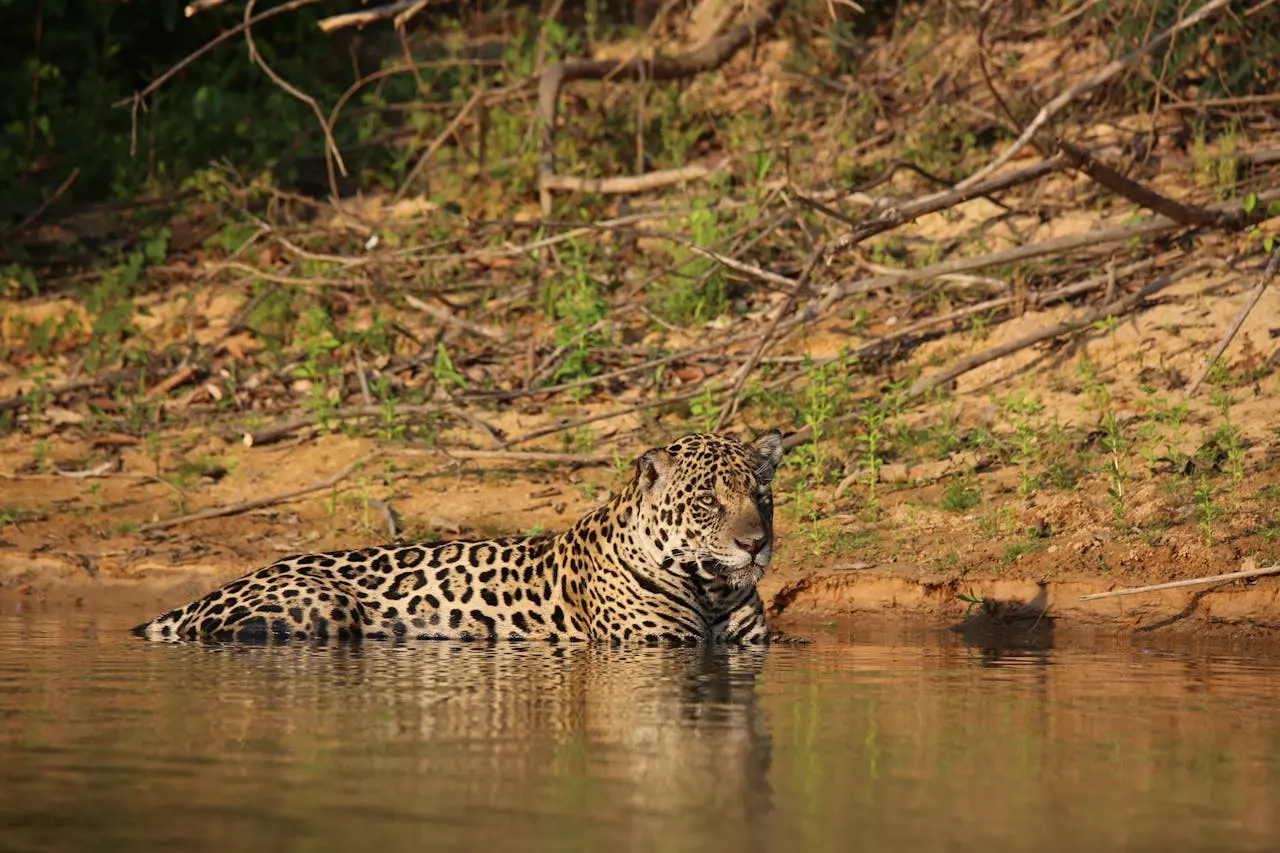Welcome to a fascinating exploration of the jaguar in Peru, a majestic symbol of Amazonian biodiversity and a silent witness to the challenges facing the rainforest. As we delve deeper into the Peruvian Amazon, we discover a region of unparalleled beauty, rich in flora and fauna, where the jaguar reigns as one of the most emblematic predators. Although spotting a jaguar in its natural habitat is a privilege reserved for few, adventures in the heart of the Amazon offer a unique opportunity to immerse yourself in this magical ecosystem. Join us to discover seven surprising facts about this incredible creature and the efforts to protect it.
1. Jaguar habitat and its challenges
Peru’s Amazon rainforest, which represents 60% of the national territory and 13% of the Amazon basin, is home to a dazzling diversity of species, including the jaguar. This unique and crucial habitat faces serious threats due to agricultural expansion, deforestation and the lack of detailed studies on jaguar populations. The situation becomes even more critical when considering that these felines are essential to the balance of their ecosystem, helping to control the populations of other species and maintain the health of the rainforest.
Fortunately, thanks to conservation initiatives by organizations such as WWF, the picture is changing. Research and protection programs are being carried out that allow a better understanding of the jaguar’s needs, favoring the creation of protected areas in which biodiversity can thrive without the constant human threat.

2. Peru: Home to one of the largest populations of jaguars
Peru is home to the second largest population of jaguars in the world. These majestic felines, which once ranged from the southwestern United States to south-central Argentina, are now found primarily in the Amazon, a region critical not only to their survival, but also to the global ecological balance.
Although the jaguar population remains significant, threats to their habitat, such as poaching, loss of territory due to agricultural expansion and illegal logging, put their future at risk. It is essential to take urgent action to reduce poaching and promote effective conservation policies.
In fact, one of the most fascinating places to experience jaguar sightings is the Tambopata region in the Peruvian jungle. If you have ever dreamed of entering the jungle and seeing the jaguar in its natural environment, this is a destination you can’t miss.
If you want to explore this fascinating region and discover its biodiversity up close, a 4-day tour to Tambopata is an excellent way to get deep into the heart of the jungle and experience its incredible natural wealth.
3. Leopard or jaguar? Find out with these details!
Although jaguars and leopards may look similar, there are notable differences between the two. One of the easiest ways to tell them apart is by looking at the rosettes on their fur. Jaguars have black spots in the center of some of their rosettes, while leopards do not. In addition, jaguars tend to have a larger head, stockier body and short legs compared to leopards.

If you are lucky and have the opportunity to see a melanistic jaguar (an almost black jaguar), it will be even more fascinating! This phenomenon occurs when the jaguar’s fur has such a dark hue that it almost looks like a shade of pitch black, making them look like a “black panther”.

4. The physical might of the jaguar
The jaguar is not only one of the most impressive felines in terms of appearance, but also in its strength and size. This feline can grow up to 170 cm long, with tails reaching 80 cm. Males can weigh up to 120 kg, while females are slightly smaller, reaching 100 kg. Their robustness and powerful musculature allow them to bring down prey much larger than themselves, making them formidable hunters.
This incredible size makes them the third largest feline in the world, after the tiger and the lion. Its strength, along with its ability to hunt animals such as caimans, deer and peccaries, gives it a prominent place in the food chain of the Amazon rainforest.
For those looking for a more in-depth jungle experience, a 7-day tour to Manu National Park offers the opportunity to explore one of the most biodiverse ecosystems on the planet and, with some luck, spot this majestic feline in its natural environment.
5. They are not afraid of water: the jaguar’s aquatic ability.
One of the jaguar’s most outstanding characteristics is its comfort in the water. Unlike other felines, jaguars are not afraid of water, in fact, they enjoy it. They are frequently found swimming through lakes, rivers and wetlands. This ability is not only an adaptation to the wet environment of the Amazon, but also allows them to hunt aquatic prey such as caimans, turtles and fish.
Thanks to their strong legs and powerful tail, jaguars can swim long distances, allowing them to move through the vast Amazonian ecosystem with agility and efficiency. This adaptability allows them to hunt in remote areas and also to access islands where other predators cannot reach.
6. A not so demanding diet
Jaguars are known to be opportunistic predators, which means that they do not have a strict diet, but hunt whatever is available in their environment. In the Tambopata region, for example, jaguars can hunt everything from capybaras, turtles and deer to monkeys, birds and fish. This flexibility in their diet allows them to survive in a wide variety of habitats, adapting to the changing conditions of their environment.
One of the jaguar’s most impressive characteristics is their ability to hunt prey much larger than themselves, using their enormous strength and powerful jaws. They can even take on other predators such as caimans without hesitation.
7. The jaguar in mythology: a symbol of power
The jaguar has been venerated throughout history by various indigenous cultures in Latin America. In Aztec mythology, for example, the jaguar was the symbol of the god Tezcatlipoca, associated with strength and power. Similarly, in Mayan mythology, the jaguar represented Ixchel, the goddess of the moon and fertility.
This feline has captured the human imagination for centuries, not only for its majestic appearance, but also for its imposing presence in nature. In many cultures, jaguars are considered sacred creatures, bearers of wisdom and power. The relationship between the jaguar and the underworld has made it an emblem of respect and mystery in numerous legends.

In conclusion, the jaguar is a truly fascinating feline and vital to the ecosystem of the Peruvian Amazon. Despite the challenges it faces, there is still hope if we work together to protect its habitat. With the support of conservation initiatives and the commitment of each of us, we can ensure that future generations will also be able to admire this magnificent animal in its natural environment.
